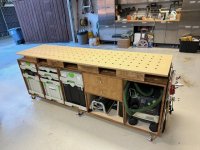HowardH
Member
I recently made an assembly table which is about 600mm deep and 2400mm long. I made an MFT top with 2x4 stand offs. It was very unwieldy to build given the size of the panels. I'm not happy with it as it's not as square as I would like it and I'm going to do it over. I was wondering if it would be better to make 4 individual boxes and screw them together like a base kitchen cabinet run. I could then use a 12mm panel running the entire length on top and bottom to really tie them together and then mount the MFT top again. I used dominos to fix the vertical panels and I wouldn't have to do that if I made individual boxes. I just seems to me my level of accuracy would be much improved as far as keeping everything perfectly square for the sys-az's I used. What do you guys think? Here's the original. Happy New Year everyone!
[attachimg=1]
[attachimg=1]

